Whitman College
Whitman College looks like an appealing place to go to school.1
When he first visited Whitman, Tanner Filion, a high school senior from Boulder, Colorado, was pleasantly surprised by Whitman’s excellent academics, outdoorsy feel, and their credible swim program that, even without a steady pipeline of highly ranked swimmers, managed to annually send a small contingent to Nationals. It looked like a pretty good option, maybe his best option.
Mr. 2,260
Because Mr. Filion wasn't receiving recruitment offers from any of the big Division III swim programs. To understand how Division III swim programs might have viewed Mr. Filion, if they even noticed him at all, look at his national recruit ranking on SwimCloud: 2,260.2
That’s a tough neighborhood for a swimmer. Looking at all the swimmers with a SwimCloud ranking between 2,250-2,300 that year3, you can see that only 21 of the 50 show any affiliation with a college or university. And showing an affiliation doesn’t mean they were recruited. Most probably weren’t. That affiliation appears even if the athlete initiated the outreach to the school and sold themselves as a swimmer, or walked on to a team after admission to the college.4 But that is not the typical outcome.
The typical outcome is that swimmers ranked in that range do not swim in college at all.
Comparing swimmers with SwimCloud rankings between 2,250-2,300 and those with rankings between, say, 500-550 reveals notable differences. Among the 50 swimmers in the 500-550 range, 40 have college affiliations linked to their records.5
And where these swimmers compete is significant. Most swimmers in the 500-550 range went D1. Those that swam Division III went to Calvin, Denison, Pomona-Pitzer, Tufts, Chicago, and WashU. Every athlete in that range who went D3 went to a school that takes a big squad to Nationals every year.
For those in 2,250-2,300 range, Division III schools were the second most common choice (far behind the leading choice - not swimming in college at all). And here are the Division III schools that these athletes attended: Hartwick College, Middlebury College, Ohio Northern University, University of Chicago, University of Lynchburg, University of Wisconsin-LaCrosse, University of Wisconsin-Stevens Point, and Whitman College.
Chicago, of course, is a major Division III program. Middlebury sends swimmers to Nationals, though last year they did not score points.6 Then there’s Whitman. And of the other five programs, none sent any swimmers to Nationals last year.
The pathway
Of course, part of what makes Division III special is that it welcomes swimmers with a range of skills and accomplishments. And athletes from across this spectrum can find a school that fits their abilities and ambitions. In Division III, you don't have to be a star to get started in collegiate swimming, and you don't need to reach Nationals to make swimming a meaningful part of your college experience. But if you want to aim for something like that, well, you are in luck. At least historically. Because choosing a program like Whitman College doesn’t mean foreclosing on the dream of someday getting to swim in some really cool meets, maybe even Nationals.
The Ultimate D3 Swimmer
A small digression to talk about Andrew Wilson of Emory.

Explaining how I rank records requires a brief plain-language technical discussion, and if you want to read that, here is the footnote.7 If you don’t care about that sort of thing, then you’ve already skipped over the rest of this paragraph, haven’t you? You aren’t even reading this.
There’s more to say about ‘Invite Times’ and that is also in the footnotes.8
When comparing current records in Division III swimming, the most remarkable Men's records are held by Andrew Wilson of Emory, Division III's most decorated Olympian.
When comparing current records in Division III swimming, the most remarkable Men's records are held by Andrew Wilson of Emory, who is also Division III's most decorated Olympian. (You can learn even more about Andrew Wilson by reading his extensive wikipedia page.)
Andrew Wilson was born in Maryland, a state with a significant presence in Olympic swimming.9 He went to Phillips Academy - an exclusive10 private boarding school with the top ranked high school swim program in Massachusetts and a storied Olympic history.
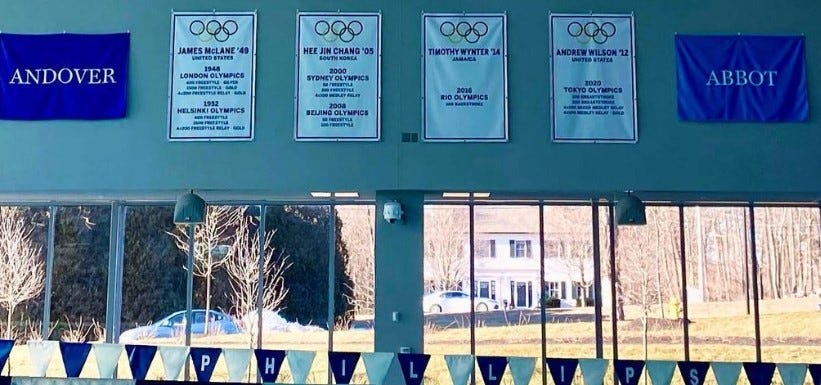
Mr. Wilson emerged as a reliable point scorer in an incredibly competitive environment11, finishing 3rd in 100 Breast in the New England Prep School Championships two years in a row.
Mr. Wilson was recruited to swim at Emory, one of the few teams to win a Division III nationals championship.12 The summer before going to Emory, he trained with the high-profile Nations Capital Swim Club (NCAP), the same program that produced Katie Ledecky, Phoebe Bacon, and several other members of the US Olympic Team.
At Emory, he took advantage of all the opportunities and resources available there,13 realized his potential to be the greatest Men’s swimmer in Division III history, and brought Emory their first Men’s National Championship.
Andrew Wilson essentially grew up in the center of the American swimming world, benefiting from top-tier coaching and training opportunities at every stage of his development, and he made more of it than any other swimmer in the history of Division III.14
Ultimate Frisbee
Tanner Filion’s story does not closely parallel Mr. Wilson’s. Mr. Filion did not swim club at all, let alone with NCAP.
Mr. Filion went to Monarch High School, a public high-school in the Boulder Valley School District. He was more of an all-around athlete, in a distinctly Colorado kind of way, competing in club Ultimate Frisbee all four years of high school (apparently they were pretty good) and doing a fair amount of skiing. Mr. Filion was also in Marching Band and an assortment of clubs and honors societies.
Monarch High School is not a traditional swimming powerhouse. It is just another good public high school with a strong swim team that practiced at a nearby rec center because, of course, the school doesn’t have its own pool.15 The year Mr. Filion graduated - and partly because of the efforts of Mr. Filion - Monarch rose to 16th place in the state, among its highest rankings in recent memory.16
By the time he was a high school Senior, Mr. Filion was a well-rounded student, and - at 5’ 8’’ - an undersized athlete, good at most sports, but great at none.
Mr. Filion was not recruited by any of the major swim programs in Division III.17 He intended to go to the University of the Puget Sound in Tacoma, Washington. Swimming factored into his college choices, as did Ultimate Frisbee. While traveling with his dad to see the school, he got a text from a former babysitter saying he should also swing by Whitman College and check it out. Tanner Filion was skeptical, but his father insisted that his son explore his options.
Tanner Filion loved what he saw at Whitman College. The school culture was relaxed, with an emphasis on outdoors activities. The academics were high-end. And they had an Ultimate Frisbee team (Mr. Filion played Ultimate all four years, including trips to Ultimate Frisbee Nationals).
About the swim program at Whitman, Tanner Filion can’t say enough good things: ‘Jenn Blomme is a great coach but an even better human. She has set up an amazing program with great culture. That’s what really sold me.’
In his first year, Mr. Filion set the Whitman team record in 200 Back. He also grew several inches, ending his first season of college swimming standing just over six feet tall. That’s not an irrelevant development. Among all the mechanical advantages in swimming, few correlate with success more than height. And fairly late in life, Mr. Filion was getting tall.
2022
Tanner Filion's next two college swimming seasons were disrupted by the COVID-19 pandemic. However, when regular swimming resumed for the 2021-22 season, it was evident that he was still on a steep growth and development curve. In a single weekend, competing against three different teams, he secured victories in the 50 Free, 100 Free, 200 Free, and 200 Back. At his conference meet, he achieved three B Cuts.
His performance at the 2022 Nationals was especially remarkable, as he made it to the A-finals in three events, including 200 Back. During the 200 Back finals, Yurii Kosian from Kenyon College broke the Division III record with a time of 1:42.90. However, Tanner Filion had already touched the wall a full 1.4 seconds earlier, setting a new Division III record in the 200 Back with an astonishing time of 1:41.49.
2023
In 2023, Tanner Filion experienced a remarkable progression, consistently winning events in dual meets and invitationals against conference rivals.
Leading up to the Northwest Conference Championships in February 2023, only three A Cuts had been achieved in Division III - Pat Pema of Emory in the 200 Free, Yurii Kosian of Kenyon in the 200 Back, and Liam McDonnell of John Carroll in the 100 Fly.
In that one weekend, Tanner Filion got three A Cuts on his own - 200 Free, 100 Back, and 200 Back.
At Nationals, Mr. Filion set two more Division III records - an astounding 45.75 in 100 Back, and he broke his own record in 200 Back setting a new mark of 1:41.17. And, maybe just for fun, he swam 100 Fly,18 and came in 3rd overall.
Adding to the unusual path of Mr. Filion’s development as a swimmer, there’s this: when he walked off the deck after his last event at Nationals and his last ever race in Division III, Tanner Filion was almost 6’ 4’’ tall. Since graduating high school, he had grown nearly eight inches.
Getting to the point
This whole comparison with Andrew Wilson has one explicit point. The two most impressive records in Men’s Division III swimming belong to Andrew Wilson. Mr. Wilson’s 200 Breast record is 8.9% faster than the average invite-time in Men’s 200 Breast, and Mr. Wilson’s time in 100 Breast (50.94) is 8.1% faster than the average invite-time for that event.
The third most impressive record in Men’s Division III swimming belongs to Tanner Filion (100 Back, 45.75, 7.1% faster than invite-average). That’s where Tanner Filion slots in to the history of Men’s Division III Swimming. Right behind Andrew Wilson.
That’s the explicit point. The implicit point is, I hope, becoming obvious.
After Nationals
Mr. Filion was the no-doubt 2023 CSCAA Division III Men’s Swimmer of the Year. And he took his extra year of eligibility to go swim at Notre Dame, a top 20 Division I program.
In his opening dual meet against Wisconsin, Tanner Filion got second place in 200 Back and grabbed the last point in 200 Free by finishing 5th. He was also part of the Notre Dame 400 Medley Relay that won the event.
If someone were to ask you - right now - ‘can the best of Division III compete in a top D1 program?’, the first person you’d point to is Tanner Filion.
And let’s never forget how he got there. Maximizing the opportunities for all Division III teams to compete at Nationals - keeping those programs viable and keeping the door open for those athletes - is not about being nice, or holding the hands of programs that can’t cut it. It is about preserving the pathway that Tanner Filion took, because the emergence of swimmers like Tanner Filion enhances the credibility of the entire division, and gives the ring of truth to the things we like to say about what makes Division III swimming so special.
Nearly 90% of students who attend Whitman College successfully complete their studies there, which stacks up well against the top schools associated with Division III swimming.
Graduation rate is a lot more meaningful than admissions rate. Whitman’s admission rate is fairly high at 59%, but that could just be a function of
They don’t spend an ungodly fortune on direct mail campaigns intended to solicit applications from students they do not intend to admit (not pointing any fingers, except at Swarthmore, definitely pointing fingers at Swarthmore), which does give a school a lot more applications to turn down, which lowers the school’s admissions rate.
They are not super-high-profile. Being high-profile encourages a lot of inappropriate applications from people who really only know the name of the school and not much else. To know about Whitman College, you might have to do a little research first, and learn a little about the school, and then maybe you only apply if you are a plausible candidate for admission.
Just saying that a lot of what drives low admissions rates - being an Ivy, spending a ton on direct mail, having an exaggerated reputation based on arbitrary ranking-sites like US News - are not the same things that drive high graduation rates. High graduation rates are much more indicative of the actual experience of going to that school.
This discussion refers to Men’s rankings.
Graduating in Spring, 2019.
Even several years after admission.
And it seems certain that they all received at least some recruitment interest.
Riley Griffis swam a solid 200 Free and didn’t miss the B Final by much.
All records are outliers but some outliers are further out than others. In Division III, one way to get a handle on how a record relates to other swims in the division is to compare the record time to ‘Invite Times’ for that event at D3 Nationals.
And if you want to smooth out some year-to-year bumps in the invite times, you could get an average of the invite times in that event for several seasons-worth of invite times. But don’t go back too far because overall times, and thus invite times, tend to improve year to year, so the further back you go the less relevant the data point.
I compromised, using an average of invite times from 2015-2019, 2022-2023. That's seven seasons of invite times per event.
That time - the average of recent invite times - becomes your 'standard time'. Then you can do this: (Standard Time - Record Time)/Standard Time. That expresses - in the form of a percentage - just how far away the record is from the average invite time. And percentages are comparable across events. So with this metric we can say if the record in one event is more extreme - more out there - than the record in another event.
‘Invite time’ refers to the time listed by the NCAA as the ‘Invited Time’ for that year. On the Hy-Tek for Nationals it is called ‘Meet Qualify’ - it’s the same thing.
One way to think about invite times is: ‘if you swim this time or faster, you get invited to swim that event at Nationals.’ That is true…enough. And the ways in which that is not completely true are pretty complicated and only marginally deepen our understanding of the process. For now, let’s file this under ‘life’s too short’ and move on.
Invite times are interesting because they are adjusted towards the end of the season and invite times are not outliers. Though the number of invites does vary from year to year, invite times always mean the same (general) thing. If you swam the invite time in an event, you were in the top X number of swimmers in Division III that season.
For Men’s events, the number of athletes invited to Nationals has been pretty stable throughout the Modern Era (since 2009), and that means a fairly stable number of athletes invited per event (with occasional outliers like 2022), which confers year-to-year comparability to this metric. In this way, invite times provide a practical (if fuzzy) assessment of just how fast those events were swum that year in Division III.
Plus, invite times are fast. At the 2023 Nationals, swimming the invite time in any Men’s event would have qualified you for the B Final (or top 16 in 800 Free Relay and 1650 Free). The only exception was 200 Free Relay - swimming the invite time for 200 Free Relay would have qualified your team for the A Final.
Between Marylanders Katie Ledecky and Michael Phelps, there were quite a few freshly minted Gold Medals about.
Maryland is also the home of several sites of NCAP, the swim program that topped USA Swimming’s Club Excellence rankings for seven straight years (until Covid reshuffled things a bit). NCAP is about to release another Olympian in Erin Gemmell. It should also be noted that Stone Ridge High School in Bethesda, Maryland - a private school with it’s own pool and an average yearly tuition of about $50,000 - is the alma mater of Ledecky, Gemmell, and Olympian (and former NCAP swimmer) Phoebe Bacon. And Johns Hopkins stand-out Makenzie Higgins.
The acceptance rate is lower than Emory’s.
In 2012, the guy finishing first went on to swim at Boston University, and the second place finisher continued his swimming career at Johns Hopkins. In 200 IM Mr. Wilson finished fifth, with the same two athletes in front of him, along with a future swimmer at Columbia and another swimmer on his way to Brown.
The Women’s team, at least. Emory Men finished second at Nationals three times in the decade leading up to Mr. Wilson’s recruitment. Emory was clearly one of the very few elite teams in Division III before Mr. Wilson arrived. In Mr. Wilson’s Senior year with Emory (2016-17), he helped the Men finally break through and win their first National Championship.
You can’t accomplish what Mr. Wilson accomplished without an ungodly amount of hard work and world-class mental toughness. No one should read any of this as a suggestion that Mr. Wilson is in any way undeserving of the many accolades he holds. Mr. Wilson had the best opportunities and he did more with them than anyone else in the history of Men’s Division III swimming.
I am not suggesting that public high schools cannot be swimming powerhouses. I am familiar with Upper Arlington, guys. I know that some public high schools have their own pools and produce dominant swim programs. That is just not what we are talking about here.
Last season, the Monarch Men’s team had a great year and rose to 10th place in Colorado in SwimCloud’s high school rankings.
Here is a short and incomplete list of the schools that did NOT recruit Tanner Filion as an undergraduate: Denison, Kenyon, Emory, Johns Hopkins, WashU, Chicago, Williams, MIT, Pomona-Pitzer, Tufts, CMS, Calvin, or NYU.
Opinion: Since COVID, Men’s 100 Fly has been the most competitive, unpredictable, and exciting individual event at Nationals. Period. In 2022, Chicago’s Jesse Ssengonzi caught Kenyon’s David Fitch (the current D3 Men’s 100 Fly record holder - 46.46) in the last 25 yards and finished with a 46.77 (a new Nationals meet record), barely 0.09 seconds faster than Mr. Fitch’s 46.86.
In 2023, Mr. Ssengonzi hit 46.47 in prelims. Let that sink in. He came within 0.01 of tying the Division III record…in prelims. In Finals, Tanner Filion was clearly in the lead at the 50 yard mark, and then gave ground to JCU’s Liam McDonnell (Mr. Filion’s current teammate at Notre Dame), Mr. Ssengonzi, and Marko Krtinic of Kenyon. Mr. Krtinic swam the back 50 in a shockingly fast 24.84, winning the event with a time of 46.51, which would have been a Nationals meet record if Mr. Ssengonzi had not gone 46.47 in prelims.
That Tanner Filion, who is basically a tourist in 100 Fly, could drop-in and finish 3rd is mind-blowing.




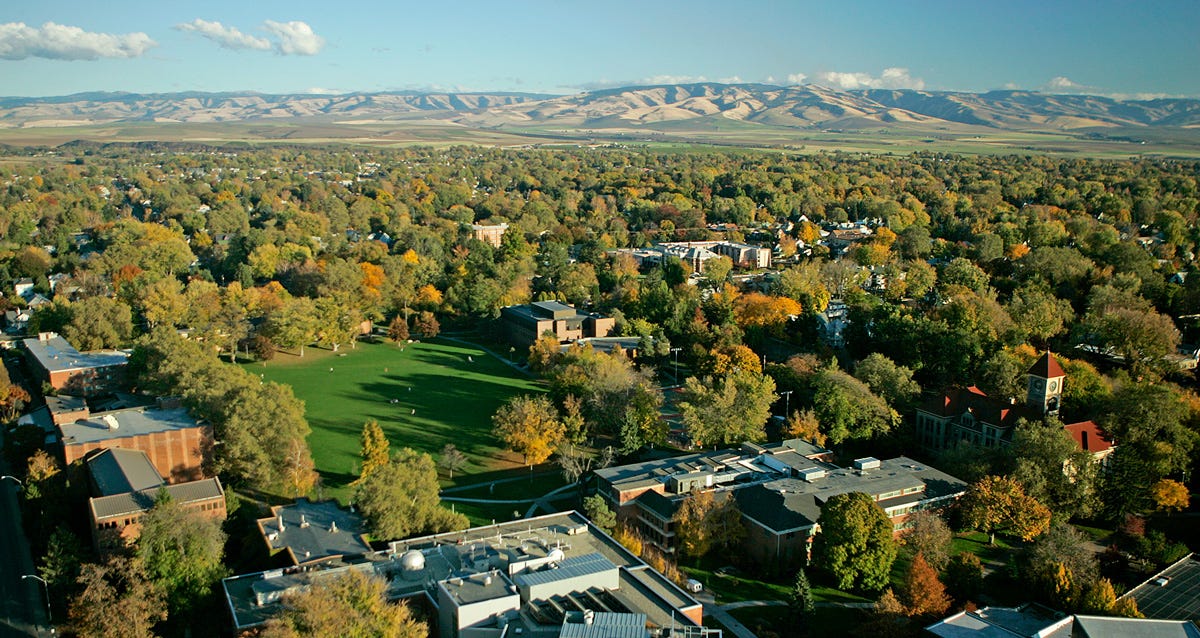
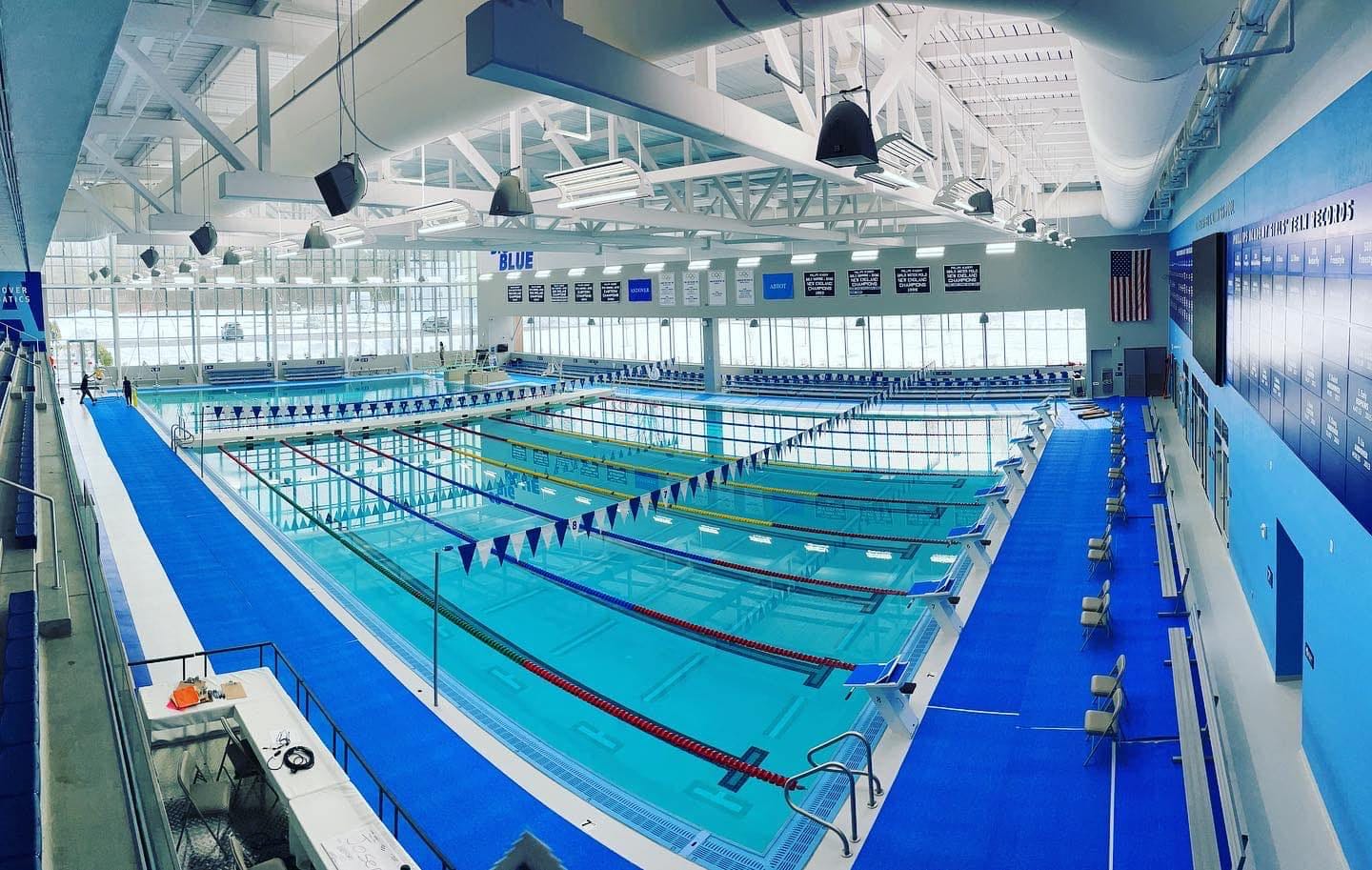
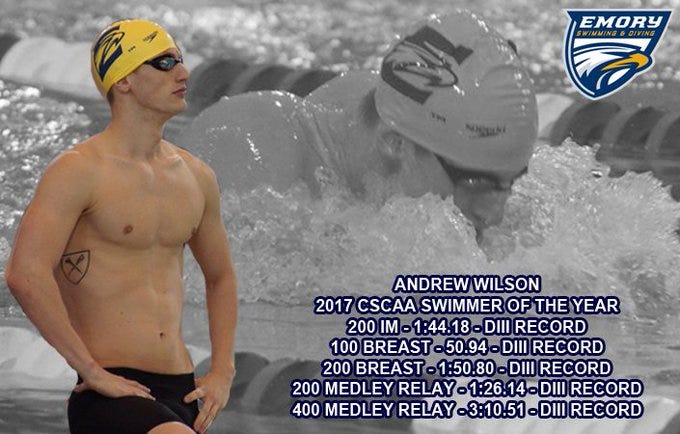


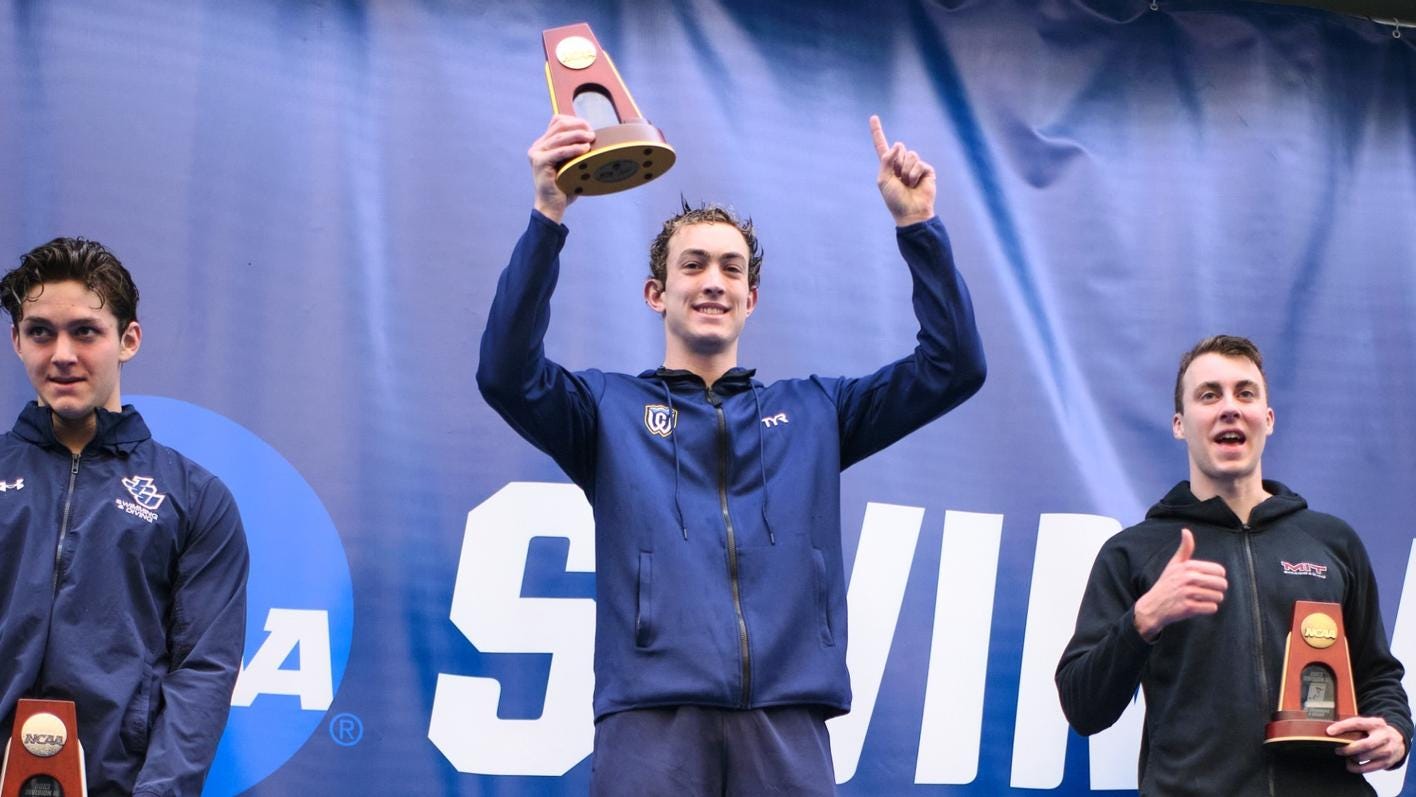

Love the Upper Arlington reference! Go bears
This is one of the best examples of swimming journalism I've read in a long time. Anyone interested in collegiate swimming below the Power 5 level can't help being captivated by Mr. Filion's journey.